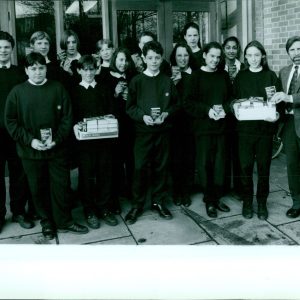640,000 people attended National Hoover Week in 1956 to learn about the revolution in home laundry technology. – Vintage Photograph
Original price was: $19.99.$15.99Current price is: $15.99.
(In Stock)
National Hoover Week, held from September 29 to October 6, 1956, drew a crowd of 640,000 people to combined exhibitions across the UK. The event was intended to educate the public on the advances in home laundry technology that had taken place in the last 20 years. This included inventions such as early British dries, washing machines with four-bladed rotors, and machines with corrugated rollers to imitate the knuckles in hand-washing. Hoover, Limited, had introduced a new machine in 1948 which had made the technology more accessible and revolutionized washing habits in millions of homes. The event was therefore a landmark in the history of home laundry technology.National Hoover Week, held from September 29 to October 6, 1956, drew a crowd of 640,000 people to combined exhibitions across the UK. The event was intended to educate the public on the advances in home laundry technology that had taken place in the last 20 years. This included inventions such as early British dries, washing machines with four-bladed rotors, and machines with corrugated rollers to imitate the knuckles in hand-washing. Hoover, Limited, had introduced a new machine in 1948 which had made the technology more accessible and revolutionized washing habits in millions of homes. The event was therefore a landmark in the history of home laundry technology.
Dimensions: 21.8 x 16.6 cm
IMS SKU: SCAN-NQOX-04869065
IMPORTANT! WHEN BUYING PHOTOS FROM US:
All the original vintage images are sold without watermarks.
All our press photos are LIMITED ARCHIVE ORIGINALS – they are not reprints or digital prints produced by us. We sell them in the same conditions they were given to us by the archives.
SEE the BACKSIDE OF the PHOTO – many times the image for sale will present stamps, dates and other publication details – these marks attest and increase the value of the press photos.
Since the photos are old press photograps they may have scratches, lines or other wears of time, which just underlines the authenticity and age of the photos.
What you will buy from us has a true historical value and authenticity. All these old photos have a story to tell and come from reliable sources.
In the past, the photos were often parts of series or were mass produced by the archives. Nowadays, their number is decimed – many were destroyed by time, use or natural disasters. Few were preserved and are nowadays carefully stored in our archives.
OCR computer generated text:
+ 2X3″
————-
National HOOVER WEEK September 29 October 6, 1956 REVOLUTION IN THE HOME LAUNDRY Washing machines-past and present homes. THERE HERE were early British dries and in some large private patents of crude wash- ing apparatus in the 17th and 18th centuries. century. In the last 20 years of the 18th century there had been interest in England and France in the mechanical use steam and boiling water for bleaching in the textile in- dustry. In the 19th century this was applied to laundry apparatus .and in 1851, following earlier ideas towards the same end, a patent was given to an A British patent in 1780 was concerned with hooking the wet fabrics at each end and twisting at one end. Other inventions at this period were concerned with the twisting of washing in sacks and with putting the clothes in a revolv- ing cylinder cage.” In the 19th century, with the industrial revolution, thousands of patents were granted in Europe and America for inventions dealing with the mechanisation of laundering. Many of the earlier patents were based on the imitation of the to and fro movement of the human hand and inven- tions appeared of tubs with In 1869, in the United States, corrugated wash-boards to rub there was invented a machine the linen, 01 with rubbing with a cylindrical body and a devices to rub the clothing four-bladed rotor at the bot- over rollers. Washing ma- tom of the tub to drive a cur- chines of this kind remained rent of water through the in use well into the present fabrics. The rotor shaft passed through the tub bottom, where it was geared for manual operation by a handle. In 1881 there was advertised There is, for example, in the Bewdley Museum in Wor- cestershire, a rocker-type washing machine of this period clothes in which the placed in a box and the whole thing rocked rather like a baby’s cradle, thus forcing the water through the fabrics. were In another type of washing machine, dating from about 1857 and made by Thomas Bradford of London and Man- chester, the clothes were tumbled in a revolving box operated by a geared handle. The box was fixed below a con- ventional mangle” and as the clothes were washed they could be removed from the box and wrung out. of the “Empire washer in various versions at from 1 10s. to 5. Martineau and. Smith’s Hardware Trade Diary and Cash Book” said of it: “The Empire Washer is the BEST machine for FAMILY USE ever offered to the public. The clothes are passed between American invention which corrugated rollers which pro- used steam and boiling water duce much the same effect as combined with a rotary move- the knuckles in hand washing. ment to clean clothes. “As the tub is zinc lined By mid-century there were there is no fear of leakage; and various types of washing after washing, the machine machines in use both in laun- may be put away until again I An early type of washing machine dating frem abcu 1857 and made by Thomas Bradford and Co., London and Manchester, compared with a Hoover (Mark III) washing machine. required, thus possessing a of the tub agiates the water, great advantage over the many while the clothes are very cumbersom Washers in the gently turned. The scapy water market.” flowing in and out of the weave of the garment washes them quickly, gently and the roughly. Early in the 20th century increased in use and then a manually operated machines great impetus was given to the development of domestic appli- ances, including washing machines, by the use of the electric motor. The latest Hoover nachines are automatically emptied by a pump anc have power wringers to wring the clothes quickly and efficier tly. They have heaters if required. When the washing is over the machine is stored easily under the draining-beard. With these machires, in an hour or twc’s work with all the back-breaking labour taken out of it, a housewife of today is able to cope quickly and easily with the fall family wash. As you use your rew gleam- ing white washing machine, spare a thought for the in- ventors of the past and of the near presen, who have success fully laboured TO take the drudgery out of wash day. Further impetus to washing machine development came be- tween the two world wars, with the growing use of elec- tricity combined with the shortage of domestic labour, and from then onwards a num- ber of different ideas for wash- ing machines were evolved. some of which are still in use at present. After the last war there was a vast increase in the use of the washing machine in Britain, and in his develop- ment Hoover, Limited, have played a leading part. In 1948 they introduced a washing machine of an entirely new design which, being highly efficient and marketed at a price which the majority of the 640,000 attended a gainfully employed households could afford, has led to revolution in washing habits in millions of homes. In the Hoover machines a small pulsator set in the side * The F.A Cup Final attracts a crowd of 100,00 to Wembley. National Hoover Week last year drew 640,00 people to the combined exhibitions.












Reviews
There are no reviews yet.